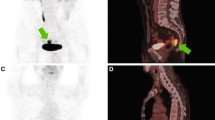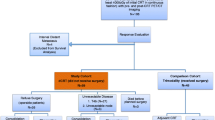Abstract
Introduction
The goal of the current study was to investigate the predictive and prognostic values of repeated F-18 FDG PET/CT parameter changes for prediction of complete pathologic response (pCR) in patients with adenocarcinoma of locally advanced esophageal cancer (LAEC) who received preoperative concurrent chemoradiotherapy (PCRT).
Methods
A total 53 patients with LAEC patients were included in the current study. All patients were evaluated by F-18 FDG PET/CT before and during chemoradiotherapy. The percent changes (∆, %) in F-18 FDG PET/CT parameters were used to predict pCR and to calculate overall survival (OS). The predictive value for pCR of F-18 FDG PET/CT cutoff values was determined by ROC analysis. The prognostic significance was assessed using Kaplan–Meier analysis.
Results
pCR occurred in 15 patients (28.3 %). When ΔSUVmax > 23.5 % was used as cutoff, the sensitivity and specificity of F-18 FDG PET/CT for prediction of pCR were 100 % and 52.6, respectively. The AUC was 0.750 (95 % CI; 0.612–0.859), and standard error (SE) was 0.0633 (p = 0.0002). ΔMTV resulted in 80 % sensitivity, 76.3 % specificity, and 0.731 AUC (95 % CI; 0.591–0.843, SE = 0.077, p = 0.0027) for cutoff values >25.5 %. When ΔTLG > 44.8 % was used as cutoff, the sensitivity and specificity of F-18 FDG PET/CT for prediction of pCR were 100 and 65.8 %, respectively. The AUC was 0.893 (95 % CI; 0.777–0.961), and SE was 0.0431 (p < 0.0001). Kaplan–Meier analysis showed that high ΔSUVmax, ΔMTV, and ΔTLG were associated with improved OS.
Conclusion
In conclusion, the current study shows the capability of the changes (Δ) in repeated F-18 FDG PET/CT parameters to predict the achievement of pCR during PCRT in LAEC patients. Among the parameters, the ΔSUVmax, ΔMTV, and ΔTLG were predictors for pCR and well associated with OS.



Similar content being viewed by others
References
Siegel RL, Miller KD, Jemal A (2015) Cancer statistics, 2015. CA Cancer J Clin 65(1):5–29
Enzinger PC, Mayer RJ (2003) Esophageal cancer. N Engl J Med 349(23):2241–2252
Panting AZ, Gossage JA, Mamidanna R, Newman G, Robinson A, Manifold DK, Hale PC (2011) Outcomes from chemoradiotherapy for patients with esophageal cancer. Dis Esophagus 24(3):172–176
Pennathur A, Gibson MK, Jobe BA, Luketich JD (2013) Oesophageal carcinoma. Lancet 381(9864):400–412
Pöttgen C, Stuschke M (2012) Radiotherapy versus surgery within multimodality protocols for easophaeal cancer- a meta-analysis of the randomized trials. Cancer Treat Rev 38(6):599–604
Kranzfelder M, Schuster T, Geinitz H, Friess H, Buchler P (2011) Meta-analysis of neoadjuvant treatment modalities and definitive nonsurgical therapy for osophageal squamous cell cancer. Br J Surg 98(6):768–783
van Hagen P, Hulshof MC, van Lanschot JJ, Steyerberg EW, van Berge Henegouwen MI, Wijnhoven BP, Richel DJ, Nieuwenhuijzen GA, Hospers GA, Bonenkamp JJ, Cuesta MA, Blaisse RJ, Busch OR, ten Kate FJ, Creemers GJ, Punt CJ, Plukker JT, Verheul HM, Spillenaar Bilgen EJ, van Dekken H, van der Sangen MJ, Rozema T, Biermann K, Beukema JC, Piet AH, van Rij CM, Reinders JG, Tilanus HW, van der Gaast A; CROSS Group (2012). Preoperative chemoradiotherapy for esophageal or junctional cancer. N Engl J Med 366(22):2074–2084
Wahl RL, Jacene H, Kasamon Y, Lodge MA (2009) From RECIST to PERCIST: evolving considerations for PET response criteria in solid tumors. J Nucl Med 50(Suppl 1):122S–150S
Flamen P, Lerut A, van Custem E, De Wever W, Peeters M, Stroobants S, Dupont P, Bormans G, Hiele M, De Leyn P, Van Raemdonck D, Coosemans W, Ectors N, Haustermans K, Mortelmans L (2000) Utility of positron emission tomography for the staging of patients with potentially operable esophageal carcinoma. J Clin Oncol 18(18):3202–3210
Kato H, Miyazaki T, Nakajima M, Takita J, Kimura H, Faried A, Sohda M, Fukai Y, Masuda N, Fukuchi M, Manda R, Ojima H, Tsukada K, Kuwano H, Oriuchi N, Endo K (2005) The incremental effect of positron emission tomography on diagnostic accuracy in the initial staging of esophageal cancer. Cancer 103(1):148–156
Ott K, Weber W, Siewert JR (2006) The importance of PET in the diagnosis and response evaluation of esophageal cancer. Dis Esophagus 19(6):433–442
Kim MK, Ryu JS, Kim SB, Ahn JH, Kim SY, Park SI, Kim YH, Song HY, Shin JH, Jung HY, Lee GH, Choi KD, Cho KJ, Kim JH (2007) Value of complete metabolic response by (18)F-fluorodeoxyglucose-positron emission tomography in oesophageal cancer for prediction of pathologic response and survival after preoperative chemoradiotherapy. Eur J Cancer 43(9):1385–1391
Huang JW, Yeh HL, Hsu CP, Lu YY, Chuang CY, Lin JC, Lin JF, Chang CF (2015) To evaluate the treatment response of locally advanced esophageal cancer after preoperative chemoradiotherapy by FDG-PET/CT scan. J Chin Med Assoc 78(4):229–234
Miyata H, Yamasaki M, Takahashi T, Murakami K, Tanaka K, Yukinori K, Nakajima K, Takiguchi S, Morii E, Hatazawa J, Mori M, Doki Y (2014) Determinants of response to neoadjuvant chemotherapy for esophageal cancer using 18F-fluorodeoxiglucose positron emission tomography (18F-FDG-PET). Ann Surg Oncol 21(2):575–582
van Heijl M, Omloo JM, van Berge Henegouwen MI, Hoekstra OS, Boellaard R, Bossuyt PM, Busch OR, Tilanus HW, Hulshof MC, van der Gaast A, Nieuwenhuijzen GA, Bonenkamp HJ, Plukker JT, Cuesta MA, Ten Kate FJ, Pruim J, van Dekken H, Bergman JJ, Sloof GW, van Lanschot JJ (2011) Fluorodeoxyglucose positron emission tomography for evaluating early response during neoadjuvant chemoradiotherapy in patients with potentially curable esophageal cancer. Ann Surg 253(1):56–63
Klayton T, Li T, Yu JQ, Keller L, Cheng J, Cohen SJ, Meropol NJ, Scott W, Xu-Welliver M, Konski A (2012) The role of qualitative and quantitative analysis of F18-FDG positron emission tomography in predicting pathologic response following chemoradiotherapy in patients with esophageal carcinoma. J Gastrointest Cancer 43(4):612–618
Malik V, Lucey JA, Duffy GJ, Wilson L, McNamara L, Keogan M, Gillham C, Reynolds JV (2010) Early repeated 18F-FDG PET scans during neoadjuvant chemoradiation fail to predict histopathologic response or survival benefit in adenocarcinoma of the esophagus. J Nucl Med 51(12):1863–1869
Elimova E, Wang X, Etchebehere E, Shiozaki H, Shimodaira Y, Wadhwa R, Planjery V, Charalampakis N, Blum MA, Hofstetter W, Lee JH, Weston BR, Bhutani MS, Rogers JE, Maru D, Skinner HD, Macapinlac HA, Ajani JA (2015) 18-fluorodeoxy-glucose positron emission computed tomography as predictive of response after chemoradiation in oesophageal cancer patients. Eur J Cancer 51(17):2545–2552
Piessen G, Petyt G, Duhamel A, Mirabel X, Huglo D, Mariette C (2013) Ineffectiveness of 18F-fluorodeoxyglucose positron emission tomography in the evaluation of tumor response after completion of neoadjuvant chemoradiation in esophageal cancer. Ann Surg 258(1):66–76
Kwee RM (2010) Prediction of tumor response to neoadjuvant therapy in patients with esophageal cancer with use of 18F FDG PET: a systematic review. Radiology 254(3):707–717
Zhu D, Ma T, Niu Z, Zheng J, Han A, Zhao S, Yu J (2011) Prognostic significance of metabolic parameters measured by 18F-fluorodeoxyglucose positron emission tomography/computed tomography in patients with small cell lung cancer. Lung Cancer 73(3):332–337
Francis RJ, Byrne MJ, van der Schaaf AA, Boucek JA, Nowak AK, Phillips M, Price R, Patrikeos AP, Musk AW, Millward MJ (2007) Early prediction of response to chemotherapy and survival in malignant pleural mesothelioma using a novel semiautomated 3-dimensional volume-based analysis of serial 18F-FDG PET scans. J Nucl Med 48(9):1449–1458
Lee HY, Hyun SH, Lee KS, Kim BT, Kim J, Shim YM, Ahn MJ, Kim TS, Yi CA, Chung MJ (2010) Volume-based parameter of 18F-FDG PET/CT in malignant pleural mesothelioma: prediction of therapeutic response and prognostic implications. Ann Surg Oncol 17(10):2787–2794
Huang W, Fan M, Liu B, Fu Z, Zhou T, Zhang Z, Gong H, Li B (2014) Value of metabolic tumor volume on repeated 18F-FDG PET/CT for early prediction of survival in locally advanced non-small cell lung cancer treated with concurrent chemoradiotherapy. J Nucl Med 55(10):1584–1590
Roedl JB, Colen RR, Holalkere NS, Fischman AJ, Choi NC, Blake MA (2008) Adenocarcinomas of the esophagus: response to chemoradiotherapy is associated with decrease of metabolic tumor volume as measured on PET-CT. Comparison to histopathologic and clinical response evaluation. Radiother Oncol 89(3):278–286
Jayachandran P, Pai RK, Quon A, Graves E, Krakow TE, La T, Loo BW Jr, Koong AC, Chang DT (2012) Postchemoradiotherapy positron emission tomography predicts pathologic response and survival in patients with esophageal cancer. Int J Radiat Oncol Biol Phys 84(2):471–477
Carvalho S, Leijenaar RT, Velazquez ER, Oberije C, Parmar C, van Elmpt W, Reymen B, Troost EG, Oellers M, Dekker A, Gillies R, Aerts HJ, Lambin P (2013) Prognostic value of metabolic metrics extracted from baseline positron emission tomography images in non-small cell lung cancer. Acta Oncol 52(7):1398–1404
Capirci C, Rubello D, Chierichetti F, Crepaldi G, Fanti S, Mandoliti G, Salviato S, Boni G, Rampin L, Polico C, Mariani G (2006) Long-term prognostic value of 18F-FDG PET in patients with locally advanced rectal cancer previously treated with neoadjuvant radiochemotherapy. Am J Roentgenol 187(2):W202–W208
Huh JW, Min JJ, Lee JH, Lee JH, Kim HR, Kim YJ (2012) The predictive role of sequential FDG-PET/CT in response of locally advanced rectal cancer to neoadjuvant chemoradiation. Am J Clin Oncol 35(4):340–344
Capirci C, Rubello D, Pasini F, Galeotti F, Bianchini E, Del Favero G, Panzavolta R, Crepaldi G, Rampin L, Facci E, Gava M, Banti E, Marano G (2009) The role of dual-time combined 18-fluorodeoxyglucose positron emission tomography and computed tomography in the staging and restaging workup of locally advanced rectal cancer, treated with preoperative chemoradiation therapy and radical surgery. Int J Radiat Oncol Biol Phys 74(5):1461–1469
Smithers BM, Couper GC, Thomas JM, Wong D, Gotley DC, Martin I, Harvey JA, Thomson DB, Walpole ET, Watts N, Burmeister BH (2008) Positron emission tomography and pathological evidence of response to neoadjuvant therapy in adenocarcinoma of the esophagus. Dis Esophagus 21(2):151–158
Larson SM, Erdi Y, Akhurst T, Mazumdar M, Macapinlac HA, Finn RD, Casilla C, Fazzari M, Srivastava N, Yeung HW, Humm JL, Guillem J, Downey R, Karpeh M, Cohen AE, Ginsberg R (1999) Tumor treatment response based on visual and quantitative changes in global tumor glycolysis using PET-FDG imaging. The visual response score and the change in total lesion glycolysis. Clin Positron Imaging 2(3):159–171
Chung MK, Jeong HS, Park SG, Jang JY, Son YI, Choi JY, Hyun SH, Park K, Ahn MJ, Ahn YC, Kim HJ, Ko YH, Baek CH (2009) Metabolic tumor volume of [18F]-Fluorodeoxyglucose positron emission tomography/computed tomography predicts short-term outcome to radiotherapy with or without chemotherapy in pharyngeal cancer. Clin Cancer Res 15(18):5861–5868
Stiekema J, Vermeulen D, Vegt E, Voncken FE, Aleman BM, Sanders J, Boot H, van Sandick JW (2014) Detecting interval metastases and response assessment using 18F-FDG PET/CT after neoadjuvant chemoradiotherapy for esophageal cancer. Clin Nucl Med 39(10):862–867
Acknowledgments
This study was supported by a grant from the National R&D Program for Cancer Control, Ministry for Health and Welfare, Republic of Korea (0920050).
Funding
This study was not funded by any grant.
Author information
Authors and Affiliations
Corresponding author
Ethics declarations
Conflict of interest
The authors reported that they have no conflicts of interest regarding to the current study.
Ethical standards
All procedures performed in studies involving human participants were in accordance with the ethical standards of the institutional and/or national research committee and with the 1964 Helsinki Declaration and its later amendments or comparable ethical standards.
Informed consent
Informed consent was waived because of retrospective characteristics of the current study.
Rights and permissions
About this article
Cite this article
Kim, SJ., Koo, P.J. & Chang, S. Predictive value of repeated F-18 FDG PET/CT parameters changes during preoperative chemoradiotherapy to predict pathologic response and overall survival in locally advanced esophageal adenocarcinoma patients. Cancer Chemother Pharmacol 77, 723–731 (2016). https://doi.org/10.1007/s00280-016-2988-8
Received:
Accepted:
Published:
Issue Date:
DOI: https://doi.org/10.1007/s00280-016-2988-8




